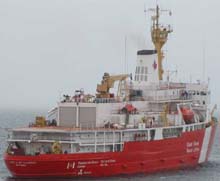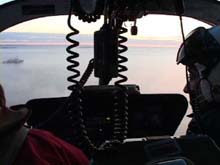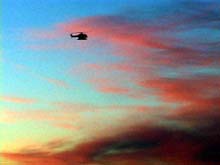
A stern-view of the 392-ft. Canadian Coast Guard Ship, the Louis St. Laurent. (Photo courtesy of David Huntley.) Click image for larger view.
Expect the Unexpected
August 15, 2002
Jeremy Potter
NOAA Office of Ocean Exploration
Plan for change! That may be the most important rule of thumb for any expedition, particularly one to the cold, white North.
The location of our first station changed even before we made it to the ship. The site, near Banks Island, seemed to be an ideal location for an ROV test. It was particularly attractive since a mooring had been lost in the shallow water there last year. Scientists hoped to use the necessary shallow ROV test dive to recover the mooring.
Unfortunately, ice analysis reports provided by Environment Canada showed thick multiyear ice had moved much farther south than they had seen in years. The preliminary cruise track developed in the months leading up to the expedition had not allowed for time to bust through the unanticipated ice. Taking the time to reach the mooring would greatly reduce precious science time needed later, when we reach the Canada Basin. It was quickly agreed to cancel the test dive near Banks Island and start farther south.
As soon as the entire exploration team and its equipment were on board, Captain Marsden pointed the Canadian Coast Guard Ship (CCGS) Louis St. Laurent west, toward our new first station in Amundsen Gulf (AG). Given our speed of 18 knots, we planned to arrive at station AG5 on the afternoon of August 15.
Our plans quickly changed about 7 pm, when the bridge received a radio distress call. Apparently, a small craft with 3 people had run low on fuel about 10 mi from shore near Coppermine (Kugluktuk), the exact location we had left early that morning.

Slowly emerging from the morning mist, the CCGS Louis St. Laurent is visible from the helicopter. Click image for larger view.
Being a Canadian Coast Guard vessel, the Louis St. Laurent’s search-and-rescue responsibilities supercede all other priorities. We immediately turned around and headed back to Coppermine at full speed.
Waves and the low angle of sight from aboard ship make spotting anybody or anything in the water extraordinarily difficult. The ship’s helicopter, with its greater field of vision, can cover a much larger search area in a fraction of the time. Though we reached the search area early in the morning, the helicopter could not launch from the ship until first light, at approximately 4:30 am.
By 5 am, the helicopter had spotted the small craft beached on a nearby island. The crew found the 3 stranded boaters safely on shore and radioed their location back to Coppermine. Within an hour of launch, the helicopter had landed safely back on the deck of the "Louis,"and we were once again heading west toward our first station at Amundsen Gulf.
Sign up for the Ocean Explorer E-mail Update List.




























